Making the Most of Audio
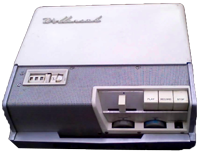 Being an old broadcast journalism guy, I remember when recording interviews in the field required lugging a reel-to-reel recorder such as the Wollensak 1500 (about $300 in 1965 dollars), tapes, and microphones. In the late 1960s, cassette recorders came along, then digital recorders of various types. Today you can record high-quality on-scene audio using a recorder that costs only about $100 and might be smaller than the microphone you take along.
Being an old broadcast journalism guy, I remember when recording interviews in the field required lugging a reel-to-reel recorder such as the Wollensak 1500 (about $300 in 1965 dollars), tapes, and microphones. In the late 1960s, cassette recorders came along, then digital recorders of various types. Today you can record high-quality on-scene audio using a recorder that costs only about $100 and might be smaller than the microphone you take along.
Wollensak was a 3M company and I owned one of their recorders way back when. It was a 2-track monarual device that was intended to allow users to lay down a second track adjacent to the primary track. One problem was that there was no way to hear the primary track when recording the secondary track.
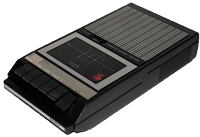 In the late 1960s, when I found myself working at a radio station in Fort Wayne, Indiana, we were issued astonishing new devices to record audio in the field: Sony cassette recorders. They were battery powered!
In the late 1960s, when I found myself working at a radio station in Fort Wayne, Indiana, we were issued astonishing new devices to record audio in the field: Sony cassette recorders. They were battery powered!
Earlier this year (9 January) I presented an interview with librarians Monica Baughman, and Susan Allen. The interview was recorded using an AKG C1000S microphone that I've used for more than a decade and a new Tascam DR-07 digital recorder. Both of these, and a microphone stand, fit in a case that's far smaller and lighter than just the Wollensak recorder by itself.
 AKG C1000S
AKG C1000S
This microphone requires phantom power, which is provided by a 9v internal battery. I use a windscreen to improve the audio quality. It's a relatively rugged microphone that has traveled with me from coast to coast and performs well in noisy environments.
When I bought the microphone, I got an outstanding deal because the company I bought it from had ordered it for a client who never came back to pick it up. Instead of $300
(today's price), I paid about $150 for it.
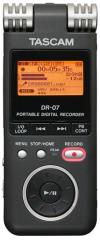 Tascam DR-07
Tascam DR-07
The recorder is smaller and lighter than the microphone. A single 8GB memory card provides up to 3 hours of high-quality (uncompressed) audio. Today's price: $98.99.
Spectacular Specs
The Tascam DR-07 will record both high-quality WAV files (44.1 or 48kHz, 16 or 24-bit) or MP3 (32kbps to 320kbps) files and the WAV file quality exceeds what can be recorded on a standard CD. Presented as the ideal recorder for a musician, it is by far the most capable field recording device I've ever owned.
When you need to record extremely long sessions, load up an 8GB memory card and record using the MP3 format. For the highest possible quality, use WAV format at 48kHz sampling rate, 24-bit depth.
Built-in stereo microphones and a wind screen might lead you believe that this device can be hand held during recording. It can't. Every vibration that reaches the case will the transmitted to the microphones and recorded. The mics will work if you place the recorder on a soft, isolated surface but a better solution is to use an external microphone.
Line-in and line-out/headphone jacks are also provided, but you'll use the USB port to copy files to a computer for digital processing. That alone is a real plus for broadcast journalists. In the old days, audio transfers were real-time; if the news conference was 20 minutes long, loading it took 20 minutes. Now it takes 20 seconds.
Some people will be surprised to find that there's no speaker. Tascam decided, correctly I think, that a small low-quality speaker in the case would add needless weight and bulk. Anyone who's interested in audio quality (the target market for the device) would use headphones.
Tascam offers several similar devices, including the DR-100 that includes 2 XLR microphone inputs. This is a $300 device aimed a high-end users.
More Than Live Audio
In the early 1970s, the movie Fool's Parade was made in Wheeling. That was about the time that I arrived there to be news director at WOMP (Bellaire, Ohio, although some of us referred to it as "Radio Free Wheeling") and my father-in-law-to-be (although I didn't know it yet) was an extra in the movie and a stand-in for George Kennedy. My wife had an old cassette recording of a radio program in which he described the event and she wondered if I could make a CD from the audio.
Most computers have only limited audio input capabilities and capturing real-time audio from a casette player would have been less than ideal, but the DR-07 has a line input that accepts either line-level or amplified signals such as those from a cassette player that doesn't include a line-out option.
So I was able to record a high-quality digital audio stream from a cassette player on the Tascam DR-07. Then I copied the resulting wav file from the Tascam to the computer, performed some clean-up work with Adobe Audition, and burned a CD for my wife and her brother. Because the audio was in digital format from the time I recorded it on the DR-07, the additional processing was lossless in terms of audio quality.
I also found on the other side of the tape several segments with my father-in-law playing the violin and speaking or singing (sometimes) in Polish.
If you want to hear the audio, it's here ...
TechByter Worldwide Now Starts on the DR-07
Since the beginning of the year I've recorded each week's program on the Tascam instead of recording direct to disk.The resulting audio seems to be better even though I'm using the same sampling, bit rate, and depth that I would use on the computer. Maybe this is because I enable the +450Hz filter.
When the recording is complete, all I need to do is copy it to the computer (I record in wav format, so the file is clean), edit, and combine with the open, close, and bumper tracks that are part of the Adobe Audition multitrack file.
 Bottom Line: Digital Recording for Everyone
Bottom Line: Digital Recording for Everyone
I am asonished that $100 will buy a digital recorder that can handle 24-bit audio. The built-in microphones aren't worth trying to use because of noise transmitted from the case, but it's easy enough to add an external microphone.
For more information, visit the Tascam website.
No Chickens, But Lots of Layers
If you've listened to me yammer about photo editing programs, you already know that my opinion of layer masks has changed. Years ago, I didn't get it but when I eventually realized that layer masks are the key to creating non-destructive edits that can be modified or removed at any time I joined the chorus that sings the praise of layers. But layers weren't available in Photoshop Elements ("Photoshop for the Rest of Us"). The latest version of Elements has layers!
Adobe keeps adding features to Photoshop Elements, features that previously were available only in the full version, the one favored by photographers and design professionals. The big dog is still Photoshop, but amateurs who can't afford Photoshop have to be delighted to see that Elements continues to improve.
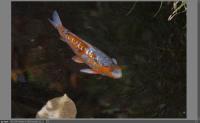 I found two images from a recent trip to the Franklin Park Conservatory and thought that they might work well together if I combined them. This is a fish that was in the same pond as the Chihuly artwork in the next image.
I found two images from a recent trip to the Franklin Park Conservatory and thought that they might work well together if I combined them. This is a fish that was in the same pond as the Chihuly artwork in the next image.
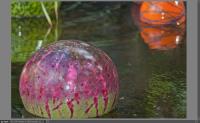 These are glass globes that artist Dale Chihuly donated to Columbus.
These are glass globes that artist Dale Chihuly donated to Columbus.
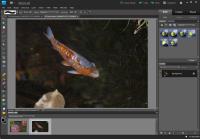 To add a layer mask, you need a layer. That means that the background image needs to be converted to a layer. That's as easy as right-clicking the background marker and selecting the convert-to-layer option.
To add a layer mask, you need a layer. That means that the background image needs to be converted to a layer. That's as easy as right-clicking the background marker and selecting the convert-to-layer option.
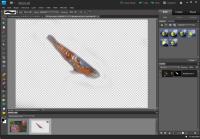 After adding a layer mask, I selected the mask and painted with a black brush to remove everything but the fish.
After adding a layer mask, I selected the mask and painted with a black brush to remove everything but the fish.
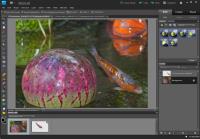 Then with the glass layer open, I dropped the fish on top and moved the layer to position the fish between the two globes.
Then with the glass layer open, I dropped the fish on top and moved the layer to position the fish between the two globes.
The size is wrong. The angle is wrong. And the fish appears to be swimming above the water.
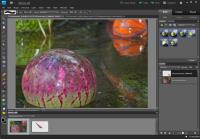 I rotated the fish and reduced the size slightly.
I rotated the fish and reduced the size slightly.
Then I added some transparency so that the fish would appear to be beneath the water.
Time to complete the project: Less than 10 minutes.
Who Shares Your Server?
If you have a website, it's probably on a server with dozens, hundreds, or thousands of other websites. Your domain and all the other domains (potentially thousands of them) share the same IP address. Nameserver routing tables direct all requests for any of these domains to the same location and then it's up to software at the server to sort out the various requests. Most of the time, this system works well.
But not always.
TechByter's IP address is 69.89.31.245, which is also the IP address for several other sites that I operate and thousands of other sites that I am not associated with in any way. The server is in Utah, home of a company called Blue Host.
Who else is on "my" server? To find out, click this link to visit Bing (it works better than Google for this exercise): http://www.bing.com/search?q=ip:69.89.31.245.
The IP address is used for all Internet services: Web, e-mail, FTP, FTPS, telnet, SSH, and so on. Most of the time there's no problem with this arrangement, but sometimes a hosting company signs up a client that doesn't play by the rules. Blue Host is good when it comes to terminating the service of these bad actors, but by the time Blue Host can discover the problem and take action, it's too late: The IP address may already have been blacklisted.
For most Internet protocols blacklisting isn't a problem. For e-mail it is. Vigilante groups that maintain e-mail blacklists use the IP address. So if one person is responsible for 69.89.31.245 being blacklisted, the other domains that use the IP address will also have trouble sending mail. And sometimes you might not even know that your messages have been blocked, no matter how important they are.
Most blacklists remove an IP address from the list after 72 hours but if you don't notice that some e-mail servers are discarding your messages, you would have no way to know that they're not getting through. Unfortunately, sometimes a system simply deletes a message without informing anyone—sender or receiver.
The solution is easy enough and not very expensive: Have your hosting service set up your accounts on a dedicated IP address. The Columbus Dispatch, for example, has a dedicated IP address: http://www.bing.com/search?q=ip:76.10.203.94. If you follow the link, you'll find several pages of domain names, but they're all owned by the Dispatch.
Another reason exists for using a dedicated IP address. If your site has a shopping cart and your payment transaction application is on your server, you'll need a dedicated IP address to obtain a security certificate so that your site's traffic will be encrypted to protect it from being observed. A dedicated IP address usually costs about $30 per year.
Short Circuits
Cameras Without Viewfinders
Last week I mentioned a couple of point-and-shoot cameras but I didn't mention that they both lack an optical viewfinder. Very few low-end cameras have even the most basic optical viewfinder today and, because my habits are as firmly entrenched as anyone else's, I was distressed about that. I didn't mention it because I thought I might be the only person who missed viewfinders.
From a reader: I notice that the new Canon camera for your briefcase has no viewfinder. [It seems that] no point-and-shoot camera has a viewfinder. This disappoints me seriously. I must be the only one--haven't seen anyone else complain about it. What can we do if we despise trying to use the screen but want a camera?
My response: Yep, that's right and it annoyed me too. Note past tense. The viewfinder makes it easier to hand-hold a slow exposure, but a display panel makes it easier to compose a shot at arm's length. The more I use the Canon, the less distressed I am about the lack of a viewfinder.
My reader responds: Maybe I could learn that too. Perhaps the display panel on today's digital cameras could be compared to the ground glass back on Ansel Adams' 8x10 camera; his composition has rarely been faulted.
Me again: And the problems are the same. In bright light, it's hard to see the viewfinder/ground-glass back. My younger daughter, the graphic designer, isn't bothered by the lack of a viewfinder and her sense of composition is almost always far better than mine.You and I will miss the viewfinder, but maybe we'll find a way to work without it.
Who Should Be LinkedIn?
Last week I sent invitations to all TechByter Worldwide subscribers to join me on LinkedIn and many people did. Some subscribers also asked questions that I felt were insightful and worth sharing.
John Kennedy, for example: "I've had a couple of other people ask me to join them in LinkedIn. I would have no problem with an invite coming from you. But I wonder what advantages joining up would have for someone like me that's retired? I know what people see (or don't see) in some of the other social networks, but what about a business-oriented social network. Maybe a good topic for your next newsletter, if there are others like me that have the same question. If I'm the only one or just a few, then maybe you could just answer back."
That is, as I told John, a very good question.
My first thought was that LinkedIn would be a way to maintain or re-establish connections with former co-workers. I'm not retired, but LinkedIn has helped me find many people I've worked with over the years. Sometimes the connection is limited to a series of catch-up messages and other times we continue chatting with each other long after the initial series of messages.
For those who are still in the workforce, other advantages include the ability to learn about new employment opportunities, join groups that are related to your business role, and generally develop a network that isn't limited by geography.
As I said to a business acquaintance in Hong Kong, "One of the coolest things about the Internet is that I can now say that I know people all around the world."
So maybe that's it: The ability to keep in touch with old friends and co-workers and the option to reach out to your friends' friends and to become their friends and acquaintances if they share some of your interests.


 The author's image: It's that photo over at the right. This explains why TechByter Worldwide was never on television, doesn't it?
The author's image: It's that photo over at the right. This explains why TechByter Worldwide was never on television, doesn't it?
